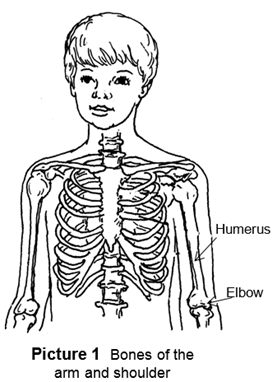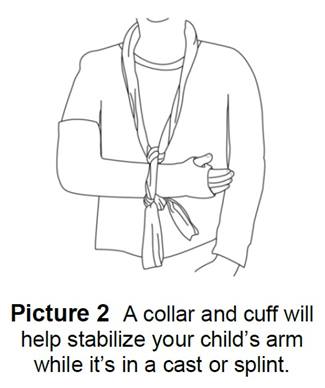Supracondylar Humerus Fracture
![]()

The humerus (hyoo-mr-uhs) is the long, thick bone in the upper arm that extends from the shoulder to the elbow. Your child’s humerus is broken (fractured) near the elbow area, just above the joint (Picture 1). This is called a supracondylar (soo-pruh-kaan-duh-lr) humerus fracture. It is the most common type of elbow fracture and happens most often to children younger than 8 years old.
Common Causes
- Fall onto an outstretched arm
- Fall directly onto the elbow
- Direct blow to the elbow
Symptoms
- Pain in the elbow
- Swelling in the elbow and hand
- Elbow or arm looks different from its usual shape
- Can't move the elbow due to pain
- Numbness in the fingers or hand
- Fingers or hand of the injured arm are cool, cold, or blue
Diagnosis
- The doctor or health care provider will ask how the injury occurred and will perform a full exam to assess pain, swelling, and circulation.
- X-rays will be taken to see if the fracture is displaced (bones are not aligned).
Treatment
Nonsurgical
- If the humerus fracture is not displaced, your child can be treated with a cast for a few weeks until the fracture heals.
- Your child will follow up in the Orthopedic Clinic for further X-rays and treatment.
Surgery
- If the bone is displaced, your child will need surgery to put the bone back into place. This surgery will be done in the operating room while your child is asleep.
- During surgery, thin pins may be put into the end of the humerus to keep the bone from moving until it heals. This procedure is called closed reduction and percutaneous pinning. Percutaneous means through the skin. If the bone cannot be aligned with the pins, the surgeon will have to make a small cut to see the fracture and place the pins this way.
- Your child will be put in a splint case for 3 to 4 weeks until the bone is healed. After that, the pins can be removed.
- Pin removal is done in the office while your child is awake. There may be a tiny bit of bleeding. The area is then covered with a bandage that stays in place for 12 to 2 hours.
Pain Control
After surgery or casting, there are a few ways to help with pain and swelling.
- Rest - No sports, gym, or other activities until your child’s doctor or health care provider says it is okay.
- Ice - Place an ice pack on the cast over the fracture for the first 48 to 72 hours.
- Elevation – Keep the elbow above the heart level for 48 hours after the cast is put on. When your child is lying down, rest the arm on enough pillows to lift hand above the level of the heart.
- Have your child move their fingers often to help blood flow to the fingers.
Pain Medicine
- Always have your child eat when they take any pain medicine.
- You may give:
- Children's Tylenol® (also called children's acetaminophen liquid 160 mg/5 mL or tablets) every 6 hours as needed for mild to moderate pain. If this is not prescribed for your child, follow the instructions on the label to find the amount of liquid or number of tablets to give your child. OR
- Children's Motrin® (also called children's ibuprofen liquid 100 mg/5 mL or tablets) every 6 hours as needed for mild to moderate pain. If this is not prescribed for your child, follow the instructions on the label to find the amount of liquid or number of tablets to give your child.
If needed, you may alternate giving your child Tylenol and Motrin every 3 hours as needed for mild to moderate pain. This would make each medicine's dose 6 hours apart.
- Your child may be prescribed 2 or 3 doses of a narcotic pain medicine called oxycodone in tables or liquid form. You may give this medicine every 6 hours as needed for severe pain.
- Constipation: Narcotics can make i hard for your child to poop (constipation). To prevent this, have your child drink a lot of water and other fluids and limit soda. Your child should eat a diet high in fiber (whole grains, fruits, and vegetables). If constipation continues, call your child's doctor or health care provider.
If your child has severe pain that does not get better after taking pain medicines, call the child's doctor or health care provider.
Cast or Splint Care
After your child gets their cast or splint, it should stay clean and dry. Do not put anything into the cast, even if it itches.
Your child will need to wear a collar and cuff (sling device) while the cast or splint is on (Picture 2). This collar and cuff should only be removed to bathe. Check the back of your child’s neck each day to make sure the collar and cuff is not rubbing and causing skin breakdown.
Recovery
Supracondylar humerus fractures often heal within 4 weeks from start of treatment (either casting or surgery). After your child’s cast is removed, it may take 4 weeks for them to be able to move their elbow normally. If your child had pins in their arm, they will get a sling or removable long arm splint. The sling or splint will need to be taken off a few times each day to work on range of motion elbow exercises. You will get these exercises when the cast is removed. The doctor will decide when the elbow strength and motion is normal and when your child can safely return to all activities. This is typically around 8 weeks after injury.
When to Call the Doctor
If any of these things happen to your child after you leave the hospital, call their orthopedic doctor, or return to the Emergency room:
- Numbness or tingling in the fingers.
- Fingers are bluish-purple in color or finer feel cold and it does not get better after elevating the arm.
- Fingers don't get pink again within 3 seconds of pressing the fingernails.
- More than a little swelling and discomfort.
- In too much pain to move the fingers.
- Fever higher than 101° Fahrenheit (F) or 38.3° Celsius (C) by mouth.
- Chills.
- Nausea or throwing up (vomiting).
Clinic Contact Information
Clinic hours at both locations are Monday through Friday, 8:00 a.m. to 4:30 p.m. Ask for the nurse to discuss any symptoms.
- Nationwide Children's Columbus
- Call (614) 72-5175 to schedule an appointment.
- Evenings, weekends, and holidays phone number is (614) 722-2000. Ask for the Orthopedic Resident on call to discuss any symptoms.
- Nationwide Children's Toledo
- Call (419) 251-2061 to schedule an appointment.
- Evenings, weekends, and holidays phone number is (567) 290-6543. Ask for the Orthopedic Resident on call to discuss any symptoms.
